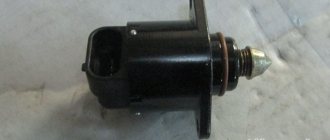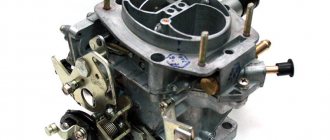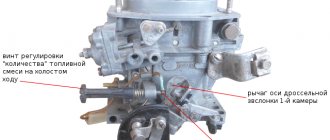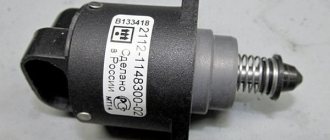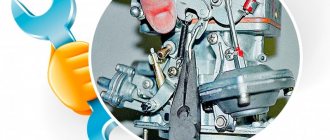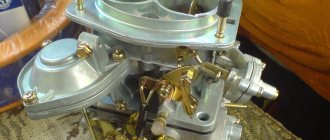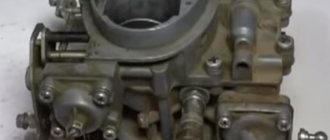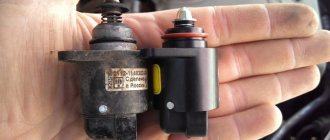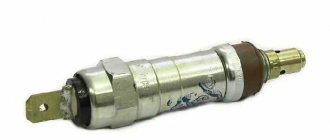Idling is the operation of the device without any load. In a car, the idle speed of the engine is when the clutch is fully depressed. At this time, torque is not transmitted from the crankshaft to the motor and wheels. In this case they are completely disconnected.
Normal idle speed is 800-1000 units. When they decrease, the engine stalls; when the number increases, excessive fuel consumption begins. What speed your car should have is indicated in the operating instructions.
Why adjust carburetor idle speed?
According to the technical characteristics of internal combustion engines, the crankshaft must rotate stably at idle, without pressing the gas pedal. The rotation speed should be in the range of 850-900 rpm. If the carburetor is not adjusted, the following problems arise:
- engine tripping;
- the engine stalls;
- high fuel consumption.
If the carburetor is not adjusted correctly, the engine will malfunction. The car picks up speed poorly (with dips), there is not enough traction.
Air leaks in a car engine.
Air leaks in a car's internal combustion engine are a very common and widespread problem. How to check the engine for air leaks? There are special smoke generators for this, but you must admit, not everyone has them, and not every service station. The principle of operation of the smoke generator is to force smoke into the intake tract of the car engine manifold. To do this, the air filter is removed and through the hole through which the engine sucks air from the filter, a portion of smoke is supplied under low pressure. The result of this procedure is the fastest and most accurate for checking the presence of air leaks in a car engine. If there is a leak somewhere, a stream of smoke will appear from there.
But what to do if you don’t have a smoke generator at hand? You can use a syringe with gasoline or a can of WD-40. Start the engine and leave it idling. Take a can of WD-40 and spray it into possible air leaks. At the same time, do not forget about safety, because this liquid can ignite (in my practice this did not happen). If liquid gets into the source of air leakage, you will immediately notice changes in the engine's idle speed. The main places where air leaks in a car engine are.
- Intake manifold gaskets and O-rings.
- O-rings and rubber bands for fuel injectors.
- O-rings and rubber bands for the idle speed sensor.
- O-rings and rubber bands for the absolute pressure sensor (MAP).
- Tubes and hoses going from the intake manifold to the adsorber valve and also to the crankcase ventilation.
- Remove the pipe going to the vacuum brake booster and plug the hole going into the intake manifold. There have been cases when air leaks occurred through a broken diaphragm of the vacuum booster.
When performing the above steps, if the culprit is among them, you will immediately see changes in the engine’s idle speed; the idle speed should level out significantly.
There is another sure and simple way to check for air leaks in a car. To do this you need to use diagnostic equipment. The diagnostic program parameters will most likely contain the “Lean mixture” error. And in the parameters of the oxygen sensor (lambda probe), look at the first oxygen sensor before the catalyst (bank 1), if there is air leakage, it will have a low voltage. The oxygen sensor monitors the composition of the mixture in the exhaust manifold by measuring the presence of oxygen in the exhaust gases. The ideal mixture is considered to be 14.7 grams of air per gram of gasoline.
If you look at the graph, during normal engine operation the graph should look like a saw. Why on a saw? I'll tell you below. When the mixture is rich, the voltage at the oxygen sensor increases, and when it is lean, it drops. A narrowband sensor operates in the range from 0 volts to 1 volt, and a broadband oxygen sensor operates from 0 volts to 5 volts, which is why they have their names (UDK and ShDC). The broadband sensor measures a wide range and is used in more expensive cars. The SDK has five wires at the output and the UDC has four.
Now we read carefully, many auto electricians do not know this!
The operating algorithm of the oxygen sensor is as follows: the engine ECU deliberately enriches the mixture by changing the fuel injection time, while monitoring the readings from the oxygen sensor. As soon as the voltage at the oxygen sensor has increased to the maximum, the ECU understands that the mixture is rich, it immediately begins to forcefully lean the mixture by changing the injection downward and again monitors the readings of the oxygen sensor. As soon as the voltage drops to a minimum, the ECU realizes that the mixture is lean, it immediately begins to enrich it. Thus, during normal engine operation, the lambda probe readings on the diagnostic program graph look like a saw. This process is repeated constantly, which allows you to keep the mixture within normal limits in all ranges. All together this is called lambda regulation.
You will probably say now, what does the idle speed and the oxygen sensor have to do with it? I answer - the oxygen sensor has nothing to do with it! Just his readings will help you understand the state of the mixture. If there is an air leak on the car, then the readings on the oxygen sensor will always be in the poor range. Why in poor? You ask. Because the oxygen sensor measures the presence of oxygen in the exhaust and if there is air leakage in the intake, then the oxygen content in the exhaust will be above normal. You will now say, but the engine sucks in a large amount of air through the filter, and how can a small air leak affect this? When air passes through the filter, its quantity is measured by the mass air flow sensor and transmitted to the ECU. Accordingly, the air leak that comes from under the injector, or gasket, or anywhere else in the intake manifold is not taken into account by the ECU.
You can do an experiment. On a working car, force air into the manifold; you can remove any small rubber tube going into the manifold and you will immediately see how the voltage on the lambda umbrella drops to a minimum. I hope it is now clear what an important role lambda regulation plays in a car.
Cases from life! “AUTO ELECTRICIAN” calls me and asks: “Can you programmatically turn off the lambda probe?” I ask - Why is this necessary? “It doesn’t work,” says the electrician. In terms of? - I ask. Buy a new sensor and replace it. The electrician replies, “we already bought a new one and it doesn’t work either” (the oxygen sensor is not cheap). And what's the reason? - I ask. The computer gives an error, “Low voltage on the DC,” the electrician answers. Well, eliminate the air leak and everything will be back to normal - I answered and refused to flash the block.
The bottom line of this story is this. The electrician, due to his incompetence, burdened the client with replacing the lambda probe. Because there is an error in the oxygen sensor, “lean mixture” or “DC voltage is too low”. Naturally, the lambda probe did what it was supposed to do, it fulfilled its direct function. When the “miracle electrician” realized that replacing the sensor did not help, he sentenced the ECU to be castrated, with which he turned to me. Can you imagine how the client would have suffered after such an electrician! The man spent a lot of money, buying and replacing an oxygen sensor, flashing the ECU, plus. As a result, he paid money to have an electrician completely ruin his car, but the original fault remained the same, only a bunch of new problems appeared!
Okay, this is not what this article is about, let’s continue to search for the problem with the idle speed of the car. I think the topic of air leaks can be closed.
Important nuances in adjusting the carburetor
It is necessary to adjust the carburetor only after the engine has warmed up to operating temperature. If you make adjustments when the engine is cold, it will operate differently after warming up. New carburetors usually do not need to be adjusted; they have optimal factory settings.
During operation, parts wear out, settings may become lost due to vibrations, so adjustments become necessary.
When setting up, you need to exclude the influence of gases from the crankcase block. To accurately adjust the carburetor, you should use a gas analyzer.
You can do without this device, but the settings will not be as accurate. The principle of setting the idle speed is the same for all carburetors of domestic cars.
The adjustment is made using two screws located on the carburetor:
- "Quality" screw. Responsible for the size of the hole for supplying fuel to the engine.
- Quantity screw. Changes the number of crankshaft revolutions.
In imported carburetors, the “quality” screw can change the cross-section of the nozzle. This adjustment is called “by air”. In such carburetors the screw is located on top of the structure. In domestic carburetors, the screw is located at the bottom, and adjustment is made “for gasoline”.
Why are the speeds not constant?
The more advanced the power system, the less noticeable the speed fluctuations. If the engine has a simple carburetor, the driver himself adjusts the idle speed. Its intervention is required if the engine temperature or load on it differs from those set when adjusting the idle speed. With an electronic carburetor with a cold start automatic, a person no longer regulates anything, but the speed increases noticeably to ensure stable operation.
What about the injection system? It will allow you to only slightly increase the idle speed until the lambda sensors warm up and hold them until the mixture formation normalizes at 100–1000 rpm. The speed may rise slightly when the load from the air conditioning system or the load from the generator increases. In all other cases, a working system should keep the speed almost constant, within ± 30 rpm.
Idle air controls and electrically driven throttle valves become dirty over time, not all spark plugs and injectors work perfectly, EGR systems leak gases, phase control systems act up, and cylinders may have different compression. It turns out that in real life, on old cars, the speeds still fluctuate a little: they either decrease unnecessarily under load or, on the contrary, increase.
Instructions for adjusting the carburetor (step by step)
Russian-made Ozon carburetors are adjusted using the gasoline method. However, in the middle of the design there is also an “air” adjustment screw, due to which you can more finely tune the air-fuel mixture supply unit to the engine. Before tuning, you need to check the condition of the throttle drive; it should not jam. This is done with a few presses on the gas pedal.
Next, the carburetor is directly adjusted as follows:
- Tighten the “quality” screw all the way.
- Carefully unscrew the screw 1.5-2 turns. Thus, the mixture is enriched as much as possible with gasoline.
- Turn the “quantity” screw 2 turns from where the throttle valve turns. This setting will ensure a normal start of the engine.
- Start the engine.
- Gradually turn the “quality” screw to reach the minimum volume of the fuel mixture at which the engine will operate stably.
- Using the “quality” screw, set the volume of the fuel mixture such that at idle the engine will operate at maximum speed.
- Gradually rotate the “quality” screw to reduce the crankshaft rotation speed to 900 rpm.
Experienced car enthusiasts tune the engine by ear. Beginners should rely on the tachometer readings. With the correct setting, the throttle will be in the closed position at idle, and in the fully open position when the gas pedal is pressed to the limit.
If you tighten the “quality” screw completely, the motor should stall. Otherwise, the throttle valve position should be adjusted because it is too open.
How are the speeds regulated?
Now it’s worth touching on the topic of how you can adjust high idle speed on the engine.
Replacing the idle air valve
Do not forget that when starting, the car engine may initially run for a short time at slightly higher idle speeds. When the engine warms up, the speed drops and reaches its normal values. First, you should find out what exactly is considered the norm specifically for your power unit.
If after warming up the speed does not drop, this indicates the presence of one or another malfunction. It must be found and eliminated. Here you should largely rely on the type of engine used.
When the engine has warmed up, but the speed still does not drop, this is considered an abnormal condition. It is imperative to determine why the performance does not return to normal at idle and what is the reason for such high engine speeds.
Some people ignore this advice, which is a big mistake. If you leave the engine in such a state, which will constantly work intensively at idle, the temperature of the internal combustion engine will begin to increase. This will be followed by engine overheating and possible cylinder head deflection. Plus, the formation of friction parts will gradually begin. The service life of the engine will be reduced, and you will speed up major repairs with your own hands or send the engine to a well-deserved rest somewhere in a landfill.
There are several main reasons for the increase in turnover. They are associated with violations and malfunctions in:
- XX regulator sensor;
- throttle position sensor;
- the throttle valve itself;
- temperature sensor;
- ECU;
- the intake manifold, where an air leak has formed.
It is important to note that on carburetor engines you can physically adjust the idle speed. What cannot be done in the case of an injection power unit. But it is possible to eliminate the reasons for the increase in speed at idle. These are different concepts, which should not be forgotten.
Adjusting Ozone carburetors 2105 and 2107
Most often, there is a need to adjust the carburetors of VAZ 2105 and 2107 cars. During the adjustment process, you need to reach a crankshaft rotation speed of 850-900 rpm.
If possible, you should achieve a volume of exhaust gases that complies with GOST for these models, but this requires a gas analyzer. Setting up with such a device is more complicated, so usually the procedure is done only at a service station.
For adjustment you need:
- Tachometer. You can rely on the readings of the standard tachometer or use a separate device.
- Slotted screwdriver 3 mm wide.
If the tachometer is missing or faulty, you can adjust the carburetor by ear. But, this setup requires some experience. The technician must determine normal, low and high speeds by the sound of the engine.
Preparing for setup
Before setting up you need:
- Check the correct ignition timing.
- Check the condition of the distributor cap, power wire, breaker contacts and spark plug. All elements must be in good working order.
- If adjustments are made after servicing the carburetor or to establish initial parameters, the adjustment screws should be fully tightened. Next, the “quantity” screw is unscrewed by 2-3 turns, the “quality” screw by 1-2.
- Warm up the engine to a temperature of 85°C to 95°C.
- Turn off the engine, connect the tachometer, and start it again.
Adjustment procedure
The setup is carried out as follows:
- Rotate the “quality” screw to reach the maximum speed level of XX.
- Achieve even higher crankshaft rotation speeds using the “quantity” screw. For example, they usually increase the speed by 80 rpm above the current one.
- Use the “quality” screw to increase the volume of the air-fuel mixture. Increase the volume of air in the mixture for better combustion by rotating the screw clockwise.
- Using the “quantity” screw, check whether this is the maximum speed for the current position of the “quantity” screw. To do this, simply scroll it first counterclockwise and then clockwise.
- By similar rotations of the “quality” screw, determine whether the maximum XX speed has been reached.
- Tighten the “quality” screw to such a position that the rotation speed is reduced to 850-900 rpm.
Why do diesel engine speeds fluctuate?
Often the reason for floating speed lies in airiness (suction of excess air) in the fuel supply system. Air can enter the diesel fuel system from different places, it all depends on the conditions and operating life of the engine. ... The tightness of the fuel line at the place where the fuel is drained back to the injectors is often broken.
Interesting materials:
How to enter the Pension Fund office? How to enter the command line on boot? How to enter the play market on android? How to enter BIOS mode? How to log into your viber? How to log into VK Ukraine? How can I reimburse the costs of paying funeral benefits from the Social Security Fund? How did Armenia come into being? How did the Republic of Vietnam come into being? How to raise a number to a power on the Citizen calculator?
Adjusting the Solex carburetor
Many VAZ car models are equipped with Solex carburetors. They are more economical and produce a higher quality air-fuel mixture. Such carburetors are adjusted as follows:
- Fully tighten the “quality” screw.
- Unscrew the “quality” screw 5 turns.
- Start the engine.
- Using the “quantity” screw, reach a rotation speed of 750 rpm.
- Use the “quality” screw to increase the speed to maximum.
- Use the “quantity” screw to reduce the speed to 800 rpm.
- Lightly tighten the “quality” screw so that the motor begins to operate slightly unstable.
- Unscrew the “quality” screw 1 turn.
- Rotate the “quantity” screw until the idle speed reaches 800 rpm. In the cold season, you can set the value to 900 rpm.
Almost any carburetor engine can be tuned this way. The instructions given are also relevant for most imported carburetors. Usually they differ only in the location of the screws.
Tuning the carburetor allows you to achieve not only stable engine operation. With proper adjustment, it is possible to reduce fuel consumption to a minimum at idle.
Why are “idlers” needed?
When the engine is running, power increases exclusively with increasing revolutions, and torque peaks in the region of medium or high speeds (on supercharged units, torque appears earlier, but also not from scratch).
To give the motor a useful load, it must already be spinning steadily and ready to produce torque. Otherwise it will simply stall. There is no way to bypass this limitation. Those speeds at which the motor can take the load are usually called idle. Speeds above idle are working.
For most passenger car engines, the idle speed is 500–900 rpm, which is not so low.
Photo instructions for setting up a carburetor for VAZ 2109
Adjustment procedure
If you have a servo drive installed, turn the steering wheel until the front wheels are in the middle position. The car must be on the handbrake. The battery must be charged. Engine oil and coolant levels must be at the correct levels.
- Every single one of the vacuum hoses needs to be connected.
- The air suction system must maintain its tightness.
- The cylinders must have good compression.
- The exhaust gas return system must be in good condition.
- The throttle valve should close and open well.
You will have to turn off the electrical consumers.
Even the cooling fan should not work. The engine must be warmed up, the thermometer needle must remain in the middle position. During operation, the engine must maintain this temperature; you must start the engine to warm it up again. Engine speed should be less than 1000 rpm.
The tachometer is connected according to the operating instructions. You will need to start the engine, and look through the carburetor sight glass and check that the fuel level is at the center line.
Then the engine speed must be increased to 2000 - 3000 rpm, and held for two or three minutes, and then allowed to idle for a minute. Look at the tachometer, the engine speed should be approximately 750±50 rpm. In the event that the speed does not correspond to the required value, you will have to rotate the screw until the value is within the required limits. And if you can’t adjust the idle speed, but the above systems work without failures, then most likely you will need to replace the carburetor.
Turn off the engine and leave the tachometer connected.
Afterwards you will need to disconnect the lambda probe plug in the middle of the exhaust manifold cover. The second plug must be disconnected from the intake air control valve. It is located on the right side of the ignition coil almost in front of the suspension strut. On the right, near the heat shield of the exhaust manifold, there is an intake tube whose task is to measure the CO content. The tube cap is removed and a device for measuring CO is connected; when connecting, you must follow the instructions. The connection between the tube and the measuring device must be airtight.
Later you need to start the engine and accelerate it to 2000 - 3000 rpm, and then return to idle. The device readings should be within 1.0±0.5%. If the CO content does not correspond to the required value, you will have to rotate the adjustment screw inserted into the throttle valve block. It is closed with a seal to prevent spontaneous rotation. There is one reason why you need to remove the carburetor; in order to drill out the seal, this work is carried out in a workshop specially designed for this. If you do the work yourself, do not drill the filling too deep. After drilling out the seal, the carburetor is installed again and the screw inside is rotated with a regular screwdriver until the CO value is established within the required limits; a new seal must be inserted into the hole.
There is no need to remove the carburetor for this.
Cars without a catalyst. On such cars, the idle speed can be adjusted in the same way as on models with an installed catalyst, however, to adjust the mixture composition, you will need a special screwdriver, which must be inserted into the notches of the adjusting screw. In order to get the best possible result, use a tachometer and a CO content measuring device. If you do not have a device, the work can be carried out without it, if the sequence is followed, however, you must remember to protect the environment.
First, you need to adjust the idle speed. You will have to do the above preparatory operations and take tachometer readings. If the speed is outside the range of 750±50 rpm, it will have to be adjusted.
Execution order
- Warm up the engine so that the operating temperature remains the same all the time.
- In order to adjust the incoming mixture, you need to use the screw that regulates the idle speed. You need to completely screw in the screw using a special screwdriver; you don’t need to tighten it too much, after which the bolt is turned out two full turns. As a result, the idle speed will increase by 50 rpm compared to the previous value. Using the same screwdriver, the adjusting screw is turned, changing the composition of the mixture; after adjustment, the engine will begin to operate at the maximum possible number of revolutions. After this, the screw must be screwed in. You also need to remember about the amount of CO; compliance with the required value is 1.5±0.5%.
The same can be done using a CO content measuring device.
Execution order
You also have to adjust the idle speed, as already described, and check that the engine maintains operating temperature. The CO measuring device is inserted into the exhaust pipe (minimum depth 40 cm). You need to check the fuel level through the inspection window; it should be on the center line. Using a special screwdriver, the mixture composition adjusting screw is turned so that the device readings have a value of 1.5±0.5%.

